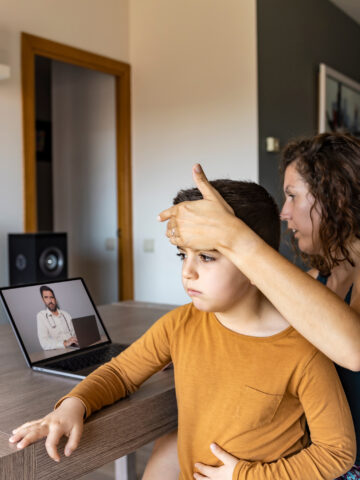It’s important that each member of your family get their flu shot every year. This is especially true this year, as COVID-19 is still circulating. Since both influenza and COVID-19 can have overlapping symptoms, it may be difficult for doctors to determine which virus is behind your symptoms based on a clinical exam alone according to Dr. Jasjit Singh, pediatric infectious disease specialist at CHOC.

“Access to testing for both viruses will be essential to determine the cause of the illness and help inform care decisions,” Singh says.
These overlapping symptoms may include, but are not limited to:
- Fever or chills
- Cough
- Shortness of breath
- Fatigue
- Sore throat
- Runny or stuffy nose
- Muscle pain or body aches
- Headache
Dr. Singh adds, “Influenza season and the ongoing COVID-19 pandemic present an overlapping utilization of the same resources, including personal protective equipment (PPE), hospital beds and equipment. It’s essential that we all do our part in curbing the spread of influenza this season to limit any potential strain on these resources.”
There is also growing concern among providers that people could become infected with both viruses at the same time, according to Dr. Singh.
“This year more than ever, it is important to get a flu shot to offer as much protection as possible from influenza,” says Dr. Singh
In this Q&A, Dr. Singh answers some other common questions parents have about the influenza vaccine amid COVID-19.
The Centers for Disease Control recommends people get vaccinated against influenza by late October, before the influenza season starts. However, it is not too late to get your flu vaccine. Anyone who has yet to receive their annual influenza vaccine should still get vaccinated. Your annual influenza vaccine can protect you from getting infected with influenza, and importantly, can also help prevent serious outcomes, including hospitalizations or death.
There is no specific time of day that makes a flu shot more or less effective. Choose a time that is convenient and available for you and your provider.
Some patients experience low-grade fever, muscle and joint aches, headaches or nausea. You cannot get an influenza infection from the flu shot, but some patients can experience mild “influenza-like symptoms” for up to two days after receiving the vaccine. Some patients also experience redness and swelling around the injection site. Here are some tips for making shots less stressful for kids.
Yes. Children can receive the flu shot and COVID-19 vaccine simultaneously. They can also receive any other necessary vaccines at the same time too.
The physician will administer each vaccine in a different injection site, likely in the same arm, so it’s possible that your children will experience some soreness in the injection sites. If in need of relief, give your child ibuprofen or acetaminophen to help with the pain. You can also place a cold, wet washcloth over the tender area.
Besides getting an influenza vaccine, washing your hands – properly and often – is the single best way to protect yourself against influenza. Here’s advice from a pediatrician on proper hand-washing.
To further protect yourself and your family from the flu this season, remember these tips:
– Stay home when you’re sick, and stay away from others who are ill
– Cover your nose and mouth when you cough
– Get enough sleep
– Eat a well-balanced diet
Getting a COVID-19 vaccination for your children and teens can help protect them from getting COVID-19 and spreading it to others. It can also keep your children from becoming seriously ill or needing hospitalization if they do contract COVID-19. It’s also important to take preventative steps:
– The CDC recommends the use of cloth face coverings in public for those over age 2 years.
– Practice physical distancing
– Avoid large gatherings, particularly indoors
– Avoid close contact with people who are sick.
– Avoid touching your eyes, nose and mouth.
– Stay home when you are sick.
– Cover your cough or sneeze with a tissue, then throw the tissue in the trash.
– Clean and disinfect frequently touched objects and surfaces using a regular household cleaning spray or wipe.
– Wash your hands often with soap and water for at least 20 seconds, especially after going to the bathroom; before eating; and after blowing your nose, coughing or sneezing.
– The CDC recommends laundering items including washable plush toys as appropriate following the manufacturer’s instructions. When possible, use the warmest appropriate water setting for the items and let them dry completely. Laundry from an ill person can be washed with other people’s items.
Check out this list of how to prepare your household for a potential COVID-19 outbreak.
Learn more about the similarities and differences between signs, symptoms and treatments of COVID-19 and the flu.
Get more expert health advice delivered to your inbox monthly by subscribing to the KidsHealth newsletter here.
Learn more about COVID Vaccines for Children and Teens
Get answers to your frequently asked questions – and some peace of mind – with this complete guide to COVID-19 vaccines from CHOC pediatric experts.





